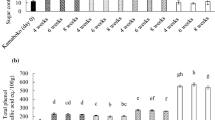Abstract
To produce doenjang with enhanced biological activities, doenjang was prepared by fermenting regular soybeans (RS), germinated soybeans (GS), and germinated black soybeans (GBS) for 90 days. The isoflavone contents in GS and GBS-doenjang were slightly higher than in RS-doenjang in the early stage of fermentation. The DPPH radical scavenging activity of GBS-doenjang was highest at 70.00% after 30 days of fermentation. The angiotensin-converting enzyme (ACE) inhibiting effects increased as the fermentation period progressed, and were significantly (p<0.05) higher in GBS-doenjang (58.69%) than in other preparations after 75 days of fermentation. The greatest fibrinolytic activities were 127.59 and 100.00% in nontreated GBS-doenjang and GBS-doenjang treated for 30 min at 55°C, respectively. There were significant (p<0.05) correlations between the total isoflavone content and the antioxidant activity (0.779) and between the isoflavone content and the ACE activity-inhibiting effects (0.669). GBS-doenjang exhibited greater antioxidant activities, ACE-inhibition, and fibrinolytic activities than RS and GS-doenjang.
Similar content being viewed by others
References
Oh HS, Park YH, Kim JH. Isoflavone contents, antioxidative, and fibrinolytic activities of some commercial cooking-with-rice soybeans. Korean J. Food Sci. Technol. 34: 498–504 (2002)
Kim JS, Yoon S. Isoflavone contents and β-glucosidase activities of soybeans, meju, and doenjang. Korean J. Food Sci. Technol. 31: 1405–1409 (1999)
Park SS, Oh SH, Choi WD, Ra KS, Suh HJ. Change in physiochemical properties during the fermentation of deonjang prepared with black soybeans. J. Food Sci. Nutr. 12: 234–241 (2007)
Kwak CS, Lee MS, Park SC. Higher antioxidant properties of chungkookjang, a fermented soybean paste, may be due to increased aglycone and malonylglycoside isoflavone during fermentation. Nutr. Res. 27: 719–727 (2007)
Jeong PH, Shin DH, Kim YS. Effects of germination and osmoproming treatment on enhancement of isoflavone contents in various soybean cultivars and cheonggukjang (fermented unsalted soybean paste). J. Food Sci. 73: H187–H194 (2008)
Shin DH. Functionality of soy fermented food and changes of manufacturing technology. Korea Soybean Dig. 21: 49–63 (2004)
Kim TW, Kim YH, Jung HJ, Park CS, Kim HY. Screening of strains with fibrinolytic activity and angiotensin-converting enzyme inhibitory activity from deonjang. Food Sci. Biotechnol. 21: 581–585 (2012)
Lee HT, Kim JH, Lee SS. Comparison of biological activity between soybean pastes adding sword bean and general soybean pastes. J. Fd. Hyg. Safety 24: 94–101 (2009)
Oh HS, Kim JH, Lee MH. Isoflavone contents, antioxidative and fibrinolytic activities of red bean and mung bean. Korean J. Soc. Food Cookery Sci. 19: 263–270 (2003)
Oh BH, Kim YS, Jeong PH, Shin DH. Quality characteristics of gochujang meju prepared with Aspergillus species and Bacillus subtilis. Food Sci. Biotechnol. 15: 549–554 (2006)
Kim HE, Han SI, Jung JB, Ko JM, Kim YS. Quality characteristics of doenjang (soybean paste) prepared with germinated regular soybean and black soybean. Korean J. Food Sci. Technol. 43: 361–368 (2011)
Kim JH, Yoo JS, Lee CH, Kim SY, Lee SK. Quality properties of soybean pastes made from meju with mold producing protease isolated from traditional meju. J. Korean Soc. Appl. Biol. Chem. 49: 7–14 (2006)
Blois MS. Antioxidant determination by the use of a stable free radical. Nature 181: 1199–1200 (1958)
Cheung HS, Chushman DW. Spectrometric assay and properties of angiotensin-converting enzyme of rabbit lung. Biochem. Pharmacol. 20: 1637–1640 (1971)
SAS Institute, Inc. SAS User’s Guide. Statistical Analysis Systems Institute, Cary, NC, USA (1990)
Jeon HY, Seo DB, Shin HJ, Lee SJ. Effect of Aspergillus oryzae-challenged germination on soybean isoflavone content and antioxidant activity. J. Agr. Food Chem. 60: 2807–2814 (2012)
Shi H, Nam PK, Ma Y. Comprehensive profiling of isoflavones, phytosterols, tocopherols, minerals, crude protein, lipid, and sugar during soybean (Glycine max) germination. J. Agr. Food Chem. 58: 4970–4976 (2010)
Wei H, Wei L, Frenkel K, Bowen R, Barnes S. Inhibition of tumor promoter-induced hydrogen peroxide formation in vitro and in vivo by genistein. Nutr. Cancer 21: 113 (1994)
Jang CH, Park CS, Lim JK, Kim JH, Kwon DY, Kim YS, Shin DH, Kim JS. Metabolism of isoflavone derivatives during manufacturing of traditional meju and doenjang. Food Sci. Biotechnol. 17: 422–445 (2008)
Kim SY, Son HS, Oh SH. Characteristics of Korean soybean paste (doenjang) preparation by the fermentation of black soybean. J. Food Sci. Nutr. 14: 134–141 (2009)
Bae EA, Moon GS. A study on the antioxidant activities of Korean soybeans. J. Korean Soc. Food Sci. Nutr. 26: 203–208 (1997)
Rhee CH, Kim WC, Rhee IK, Lee OS, Park HD. Changes in the physicochemical property, angiotensin converting enzyme inhibitory effect and antimutagenicity during the fermentation of Korean traditional soy paste (doenjang). Korean J. Food Preserv. 13: 603–610 (2006)
Radnaabazar C, Park CM, Kim JH, Cha J, Song YS. Fibrinolytic and antiplatelet aggregation properties of a recombinant cheonggukjang kinase. J. Med. Food 14: 625–629 (2011)
Kim MH, Kim SY, Jeong DY, Kim YS. Biological activities of cheonggukjang prepared with several soybean cultivars. Food Sci. Biotechnol. 21: 475–483 (2012)
Author information
Authors and Affiliations
Corresponding author
Rights and permissions
About this article
Cite this article
Kim, HE., Kim, YS. Biological activities of fermented soybean paste (Doenjang) prepared using germinated soybeans and germinated black soybeans during fermentation. Food Sci Biotechnol 23, 1533–1540 (2014). https://doi.org/10.1007/s10068-014-0209-y
Received:
Revised:
Accepted:
Published:
Issue Date:
DOI: https://doi.org/10.1007/s10068-014-0209-y




